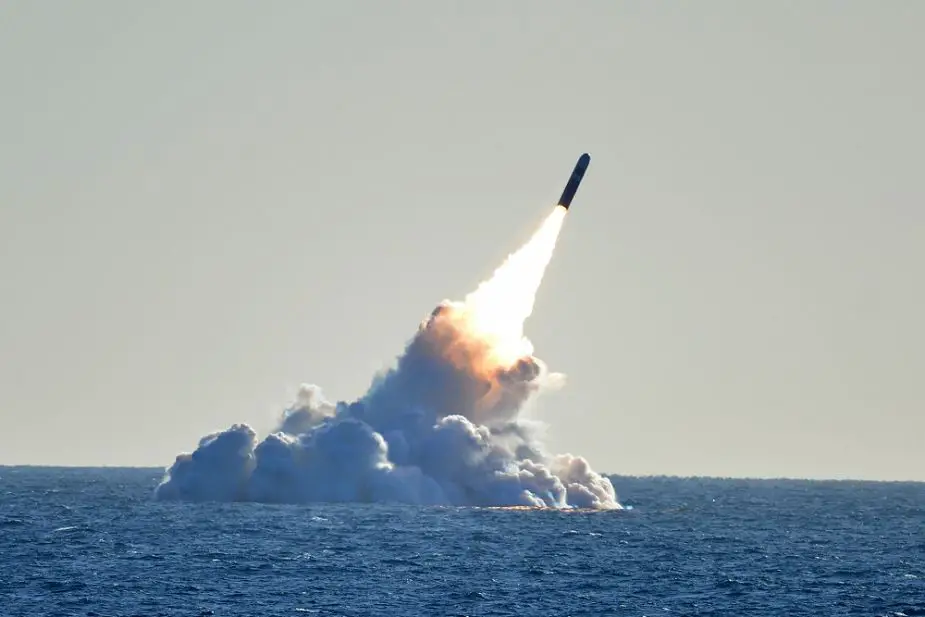Breaking news
Lockheed Martin Space was awarded a contract to produce Trident II D5 naval ballistic missile.
On February 14, 2020, it was announced by U.S. Government that Lockheed Martin Space, Titusville, Florida, was awarded a $13,860,565 cost-plus-fixed-fee modification (P00004) to exercise options under a previously awarded and announced a contract for Trident II (D5) missile production and deployed systems support.
 An unarmed Trident II D5 missile launches from the Ohio-class ballistic missile submarine USS Nebraska (SSBN 739) off the coast of California.(Picture source U.S. DoD)
An unarmed Trident II D5 missile launches from the Ohio-class ballistic missile submarine USS Nebraska (SSBN 739) off the coast of California.(Picture source U.S. DoD)
Work will be performed in Cape Canaveral, Florida (62.3%); Sunnyvale, California (35.9%); and other various locations (less than 1% each; 1.8% total). Work is expected to be completed Sept. 30, 2024.
The Trident II D5 is the latest generation of the U.S. Navy's submarine-launched fleet ballistic missiles, following the highly successful Polaris, Poseidon, and Trident I C4 programs. The Trident II SWS is deployed aboard Ohio-class submarines, each capable of carrying 20 D5 missiles. Under the provisions of the Polaris Sales Agreement, it is also carried aboard the United Kingdom's Vanguard-class submarines. It was first deployed in March 1990, and remains in service. The Trident II Strategic Weapons System is an improved SLBM with greater accuracy, payload, and range than the earlier Trident C-4.
The first Fleet Ballistic Missile (FBM) developed and deployed by the United States was the Polaris A1 missile, named for the North Star. A two-stage ballistic missile with a range of 1,200 nautical miles, the A1 was powered by solid fuel rocket motors and guided by a self-contained inertial guidance system independent of external commands or control. The A1's first successful underwater launch from a submarine on July 20, 1960, brought to fruition a remarkable Navy and industry research and development effort begun only four years earlier. Subsequent Polaris missiles, the A2 and A3, increased the range and thus the operating area of the stealthy deterrent. U.S. deployment of the Polaris missile series ended with the retirement of the A3 in 1979.
The next generation of fleet ballistic missiles to follow Polaris was the Poseidon C3 missile. The Poseidon, despite being 20 inches wider in diameter, 36 inches longer and approximately 30,000 pounds heavier, fit into the same 16 launch tubes that carried Polaris. Poseidon carried twice the payload of the Polaris A3 with significantly improved accuracy. The first Poseidon test launch occurred on August 16, 1968. The first submarine-based test launch occurred on August 3, 1970, from SSBN 627 James Madison. The Poseidon was declared operational on March 31, 1971, and was deployed aboard all 31 Lafayette Class submarines.
The Trident I C4 missiles were the longest continuously operated Fleet Ballistic Missiles ever deployed by the U.S. Navy. Using advanced technology in propellants, micro-electronics and new weight-saving materials, the Trident I C4 missile incorporated the multiple independently-targeted vehicle capability of its predecessor Poseidon and provided an astounding range of more than 4,000 nautical miles with a full payload.
The Trident II D5 SLBM is a three-stage, solid-fuel, inertially-guided missile with a range of 4,000 nautical miles capable of carrying multiple W76-Mk4/Mk4A or W88-Mk5 reentry bodies. The missile is launched by the pressure of expanding gas within the launch tube. When the missile broaches the waterline, it enters the boost phase, expending its first, second, and third-stage rocket motors. Following third-stage motor separation, the missile deploys the reentry bodies.


























